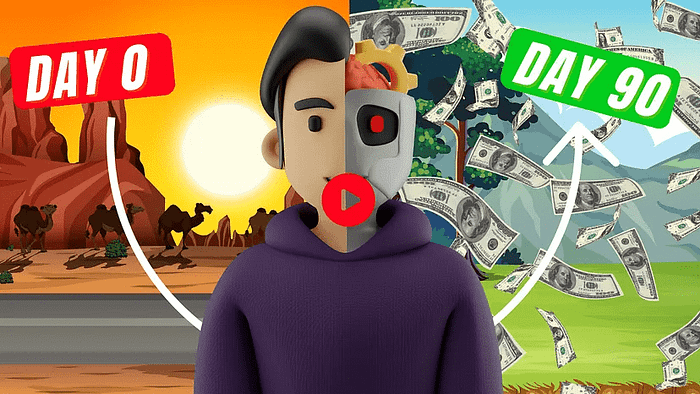10 Essential ChatGPT Prompts for Students to Ace Their Studies
Mastering the Art of Effective Prompts for Enhanced Learning
Forget dusty textbooks and boring lectures! ChatGPT prompts for students are revolutionizing the way we learn.
These AI-powered tools are like having a super-smart study buddy available 24/7.
But here’s the catch: you need to know how to use them right.
That’s where this guide comes in handy.
We’re about to dive into 10 game-changing ChatGPT prompts for students that’ll transform your study sessions.
These aren’t just any prompts – they’re your secret weapons for academic success.
So, get ready to supercharge your learning and leave those all-nighters in the dust!
We strongly recommend that you check out our guide on how to take advantage of AI in today’s passive income economy.
Table of Contents
1. The Explanation Expert: “Explain [topic] as if I’m a complete beginner”
When tackling a new subject, sometimes you need to start from square one.
That’s where this ChatGPT prompt for students comes in clutch.
By asking ChatGPT to explain a topic as if you’re a total newbie, you’re setting yourself up for a clear, jargon-free explanation.
This prompt is like having a patient tutor who never gets tired of breaking things down.
Imagine you’re struggling with photosynthesis in biology class.
You could say, “Explain photosynthesis as if I’m a complete beginner.”
ChatGPT would then provide a simple, step-by-step breakdown, using everyday language and relatable analogies.
It might compare the process to a plant’s way of “eating” sunlight and air to make its food.
This approach helps you grasp the basics before diving into more complex aspects.
It’s particularly useful for subjects that seem overwhelming at first glance.
Whether it’s quantum physics or Shakespeare’s sonnets, this prompt helps you build a solid foundation.
Remember, there’s no shame in going back to basics – in fact, it’s often the key to mastering advanced concepts later on.
So, don’t be afraid to use this ChatGPT prompt for students whenever you need a fresh perspective on a tricky topic.
2. The Question Generator: “Create a list of 10 practice questions about [topic]”
Testing yourself is one of the most effective ways to learn and retain information.
But coming up with good questions can be a challenge in itself.
That’s where this ChatGPT prompt for students shines.
By asking ChatGPT to generate practice questions, you’re essentially creating a personalized quiz for yourself.
This prompt is like having a teacher who knows exactly what you need to study.
Let’s say you’re preparing for a history exam on World War II.
You could input, “Create a list of 10 practice questions about World War II.”
ChatGPT would then generate a variety of questions, ranging from multiple-choice to short answer formats.
These might include questions about key dates, major battles, political leaders, and the war’s impact on society.
The beauty of this prompt is its versatility.
You can use it for any subject, from math to literature, and adjust the difficulty level as needed.
Want more challenging questions? Just specify that in your prompt.
This approach not only helps you review material but also identifies areas where you might need more study.
If you struggle with certain questions, you know where to focus your efforts.
By regularly using this ChatGPT prompt for students, you’ll be well-prepared for exams and develop a deeper understanding of your subjects.
3. The Analogy Maker: “Compare and contrast [concept A] with [concept B]”
Understanding complex ideas often becomes easier when we relate them to familiar concepts.
This is where the power of analogies comes into play, and ChatGPT is an expert at creating them.
By using this ChatGPT prompt for students, you’re asking the AI to draw connections between different ideas, helping you see the bigger picture.
It’s like having a creative teacher who can make even the most abstract concepts tangible and relatable.
For instance, if you’re studying economics, you might ask, “Compare and contrast supply and demand with a seesaw.”
ChatGPT would then explain how supply and demand balance each other out, just like two people on opposite ends of a seesaw.
When demand (one person) goes up, prices rise, just like that side of the seesaw.
This prompts suppliers to produce more, bringing prices back down, similar to how the other person on the seesaw would lower their side.
This kind of comparison can make abstract economic principles much more concrete and memorable.
The beauty of this ChatGPT prompt for students is its flexibility.
You can use it to compare anything: historical events, scientific processes, literary characters – you name it.
By seeing how different concepts relate to each other, you’ll develop a more nuanced understanding of your subjects.
This approach also encourages critical thinking, as you start to see connections between seemingly unrelated ideas.
So, next time you’re grappling with a tough concept, try this ChatGPT prompt for students and watch those lightbulb moments happen!
4. The Study Plan Creator: “Design a 2-week study plan for [subject]”
Effective studying isn’t just about hitting the books – it’s about having a solid game plan.
That’s where this ChatGPT prompt for students becomes your personal study coach.
By asking ChatGPT to create a study plan, you’re setting yourself up for success with a structured approach to learning.
It’s like having an experienced tutor who knows how to break down complex subjects into manageable chunks.
Let’s say you’re preparing for a big chemistry exam.
You could input, “Design a 2-week study plan for organic chemistry.”
ChatGPT would then craft a detailed schedule, breaking down topics day by day.
It might suggest starting with basic concepts like molecular structure in the first few days, then progressing to more complex topics like reaction mechanisms later in the plan.
The AI could also incorporate different study techniques, like flashcards for memorizing formulas and practice problems for applying concepts.
What makes this ChatGPT prompt for students so powerful is its ability to create personalized plans.
You can specify your available study time, areas you find challenging, and even your preferred learning style.
The resulting plan will be tailored to your needs, making your study sessions more efficient and effective.
This approach helps you avoid the common pitfall of last-minute cramming.
Instead, you’ll have a clear roadmap for covering all necessary material in a timely manner.
By using this ChatGPT prompt for students regularly, you’ll develop better time management skills and reduce exam stress.
Remember, a well-structured study plan is your secret weapon for academic success!
5. The Concept Connector: “How does [topic A] relate to [topic B] in [subject]?”
One of the hallmarks of true understanding is the ability to see connections between different concepts.
This ChatGPT prompt for students is designed to help you do just that.
By asking how different topics relate to each other, you’re encouraging a deeper, more holistic understanding of your subject.
It’s like having a wise professor who can show you how all the pieces of the puzzle fit together.
For example, if you’re studying biology, you might ask, “How does cellular respiration relate to photosynthesis in plant biology?”
ChatGPT would then explain how these two processes are interconnected, with one using the products of the other.
It might describe how the glucose produced during photosynthesis becomes the fuel for cellular respiration, and how the carbon dioxide released during respiration can be used in photosynthesis.
This kind of connection-making is crucial for developing a comprehensive understanding of complex subjects.
It helps you move beyond memorizing isolated facts to seeing the big picture.
This ChatGPT prompt for students is particularly useful when preparing for essay questions or open-ended exams.
By understanding how different topics relate, you’ll be better equipped to provide thorough, insightful answers.
You can use this prompt for any subject, from history (How does the Industrial Revolution relate to urbanization?) to literature (How does the theme of love in Romeo and Juliet relate to the theme of fate?).
The more you practice making these connections, the more natural it will become.
You’ll start to see patterns and relationships everywhere, enhancing your critical thinking skills.
So, don’t hesitate to use this ChatGPT prompt for students to uncover the hidden connections in your studies!
6. The Practical Application Finder: “Give real-world examples of [concept] in action”
Sometimes, academic concepts can feel abstract and disconnected from everyday life.
That’s where this ChatGPT prompt for students comes in handy.
By asking for real-world examples, you’re bridging the gap between theory and practice.
It’s like having a mentor who can show you how classroom learning applies to the “real world.”
Let’s say you’re studying physics and struggling to grasp the concept of momentum.
You could ask, “Give real-world examples of momentum in action.”
ChatGPT might then describe how momentum plays a role in sports (like a football player’s tackle), transportation (the difficulty of stopping a moving train), or even cooking (stirring a pot of soup).
These tangible examples make abstract concepts more relatable and easier to understand.
This ChatGPT prompt for students is particularly useful for subjects that might seem purely theoretical at first glance.
Whether it’s mathematical concepts, scientific theories, or philosophical ideas, seeing how they apply in real life can make them more engaging and memorable.
It can also help you appreciate the relevance of what you’re learning.
When you understand how a concept applies in the real world, you’re more likely to remember it and use it later.
This approach can be especially motivating for students who learn best through practical applications.
By regularly using this ChatGPT prompt for students, you’ll start to see the world around you as a living textbook, full of examples of the concepts you’re studying.
This not only enhances your understanding but also makes learning more enjoyable and relevant.
So, next time a concept seems too abstract, ask ChatGPT to bring it down to earth with some real-world examples!
7. The Summarizer: “Summarize the key points of [topic] in bullet points”
When you’re dealing with a mountain of information, it’s easy to get lost in the details.
That’s where this ChatGPT prompt for students becomes your personal information distiller.
By asking for a bullet-point summary, you’re getting a concise overview that captures the essence of a topic.
It’s like having a skilled note-taker who can extract the most important information from any lecture or textbook.
Imagine you’ve just read a long chapter on the French Revolution and you’re feeling overwhelmed.
You could say, “Summarize the key points of the French Revolution in bullet points.”
ChatGPT would then provide a clear, organized list of the most crucial events, figures, and concepts.
This might include points like the storming of the Bastille, the Declaration of the Rights of Man, and the rise of Napoleon Bonaparte.
This approach is incredibly useful for revision and quick review.
Instead of re-reading entire chapters, you can use these summaries to refresh your memory and focus on the most important points.
This ChatGPT prompt for students is versatile and can be applied to any subject or topic.
Whether you’re studying literature, science, or history, a concise summary can help you organize your thoughts and identify the core concepts.
It’s particularly helpful when preparing for exams or writing essays, as it gives you a clear structure to work with.
By regularly using this prompt, you’ll develop the skill of identifying key information – a valuable ability in both academic and professional settings.
Remember, while summaries are great for quick review, they shouldn’t replace in-depth study.
Use this ChatGPT prompt for students as a complement to your regular study methods, not a substitute.
With practice, you’ll become adept at distilling complex information into manageable chunks, making your study sessions more efficient and effective.
8. The Perspective Shifter: “Explain [topic] from the perspective of [person/character]”
Sometimes, the best way to understand a concept is to look at it from a different angle.
This ChatGPT prompt for students encourages creative thinking by asking you to consider topics from unique perspectives.
It’s like having an imaginative teacher who can bring subjects to life through role-play and storytelling.
This approach can be particularly engaging and memorable, making learning feel more like an adventure than a chore.
For instance, if you’re studying climate change, you might ask, “Explain climate change from the perspective of a polar bear.”
ChatGPT would then craft a narrative that describes the impacts of global warming from the viewpoint of an animal directly affected by it.
This could include details about shrinking ice habitats, changes in food availability, and the challenges of adapting to a warming Arctic.
By putting yourself in the “paws” of a polar bear, you gain a more emotional and personal understanding of the issue.
This ChatGPT prompt for students isn’t just for science topics – it can be applied to any subject.
In history, you might ask for an explanation of World War II from the perspective of a civilian in occupied France.
For literature, you could explore “Romeo and Juliet” from the viewpoint of the Nurse or Mercutio.
This approach encourages empathy and critical thinking, as you consider how different individuals or characters might interpret events or ideas.
It’s also a great way to make dry or complex topics more engaging and relatable.
By regularly using this ChatGPT prompt for students, you’ll develop the ability to consider multiple perspectives – a valuable skill in academic analysis and real-world problem-solving.
So, next time you’re struggling to connect with a topic, try shifting your perspective and see how it transforms your understanding!
9. The Debate Stimulator: “Present arguments for and against [topic]”
Developing critical thinking skills is crucial for academic success, and there’s no better way to sharpen these skills than through debate.
This ChatGPT prompt for students helps you explore different sides of an issue, encouraging a balanced and nuanced understanding.
It’s like having a debate coach who can present both sides of an argument clearly and persuasively.
This approach is particularly valuable for subjects that deal with complex or controversial topics.
Let’s say you’re studying the pros and cons of social media.
You could ask, “Present arguments for and against the widespread use of social media.”
ChatGPT would then provide a balanced overview, discussing points like improved connectivity and information sharing on one side, and concerns about privacy and mental health on the other.
This balanced presentation helps you understand the complexity of the issue and form your own informed opinion.
This ChatGPT prompt for students is incredibly versatile and can be applied to topics in virtually any subject.
In science, you might explore arguments for and against genetically modified organisms.
In history, you could examine different perspectives on a significant event or policy.
In literature, you might debate the motivations of a controversial character.
By considering multiple viewpoints, you develop a more comprehensive understanding of the topic.
This approach also prepares you for essay writing and class discussions, where you’ll need to present balanced arguments.
It helps you anticipate counterarguments and strengthen your own position.
Regular use of this ChatGPT prompt for students will enhance your ability to think critically and argue persuasively – skills that are valuable far beyond the classroom.
Remember, the goal isn’t to “win” the debate, but to understand the complexity of the issue and form a well-reasoned opinion.
So, embrace the power of debate and watch your understanding of complex topics flourish!
10. The Analogy Creator: “Explain [complex topic] using an analogy to [familiar concept]”
Sometimes, the best way to grasp a difficult concept is to relate it to something you already understand well.
This ChatGPT prompt for students is all about creating powerful analogies that bridge the gap between the unfamiliar and the familiar.
It’s like having a creative teacher who can make even the most abstract ideas concrete and relatable.
This approach can be a game-changer when you’re struggling with complex or abstract concepts.
For example, if you’re having trouble understanding how computer networks function, you might ask, “Explain how the internet works using an analogy to a postal system.”
ChatGPT would then craft an analogy comparing data packets to letters, routers to post offices, IP addresses to mailing addresses, and so on.
This familiar framework makes it easier to understand how information travels across the internet.
The beauty of this ChatGPT prompt for students is its flexibility – you can use it for any subject or topic.
In biology, you might ask for an analogy comparing DNA replication to a library copying system.
For economics, you could request an explanation of inflation using an analogy to a balloon.
In physics, you might seek an analogy comparing the structure of an atom to a solar system.
By creating these connections between complex ideas and familiar concepts, you’re building mental bridges that enhance understanding and retention.
This approach is particularly useful for visual or kinesthetic learners who benefit from concrete representations of abstract ideas.
It can also make studying more enjoyable, as you start to see connections between your studies and the world around you.
Regular use of this ChatGPT prompt for students will enhance your ability to explain complex ideas simply – a valuable skill in both academic and professional settings.
So, next time you’re faced with a challenging concept, try asking for an analogy.
You might be surprised at how quickly that tricky topic becomes clear!
Conclusion:
Congratulations! You’ve just unlocked a treasure trove of ChatGPT prompts for students.
These powerful tools are your ticket to academic success and deeper understanding.
From breaking down complex topics to creating personalized study plans, these prompts cover all bases.
Remember, the key is to use them regularly and creatively.
Don’t be afraid to mix and match prompts to suit your needs.
With practice, you’ll find yourself asking more insightful questions and gaining deeper insights.
These ChatGPT prompts for students aren’t just about acing exams – they’re about developing lifelong learning skills.
Critical thinking, creativity, and the ability to see connections will serve you well beyond your school years.
So, embrace these tools and watch your academic performance soar!
Happy studying, and remember – with the right prompts, ChatGPT can be your ultimate study buddy.
Keep experimenting, keep learning, and most importantly, enjoy the journey of discovery these prompts can take you on.
Your academic success story starts here, with these game-changing ChatGPT prompts for students.
Now go forth and conquer those studies!
Maximizing Your Learning Potential with AI-Assisted Study Techniques
Now that we’ve explored the 10 essential ChatGPT prompts for students, let’s dive deeper into how to maximize their potential.
These prompts are more than just questions – they’re keys to unlocking your full learning capacity.
By integrating these ChatGPT prompts for students into your study routine, you’re not just studying harder, but smarter.
Think of these prompts as your personal learning accelerators, designed to boost your understanding and retention.
But like any tool, their effectiveness depends on how you use them.
Let’s explore some strategies to get the most out of these ChatGPT prompts for students.
First, consistency is key.
Make these prompts a regular part of your study sessions, not just a last-minute exam prep tool.
By consistently engaging with these prompts, you’re training your brain to think more critically and creatively.
Next, don’t be afraid to experiment.
While we’ve provided 10 essential prompts, feel free to modify them or create your own based on your specific needs.
The more you personalize these ChatGPT prompts for students, the more effective they’ll be for your unique learning style.
Remember, ChatGPT is incredibly versatile.
You can use these prompts for any subject, from quantum physics to ancient history.
The key is to approach each topic with curiosity and a willingness to explore different angles.
Another tip: use these prompts in combination.
For example, after using the summarizer prompt, follow up with the debate stimulator to deepen your understanding.
This multi-faceted approach ensures a comprehensive grasp of the material.
Don’t forget to reflect on your learning process.
After using these ChatGPT prompts for students, take a moment to consider what you’ve learned and how your understanding has improved.
This metacognitive practice enhances retention and helps you identify areas for further study.
Lastly, share these prompts with your classmates.
Learning is often more effective when it’s collaborative.
By discussing the insights you’ve gained from these prompts, you’re reinforcing your own understanding and helping others.
Frequently Asked Questions:
How to write ChatGPT prompts to get the best results?
Writing effective ChatGPT prompts is key to getting the best results.
Here are some tips:
- Be specific and clear in your request.
- Provide context for your question or task.
- Use descriptive language to guide the AI’s response.
- Break complex requests into smaller, manageable parts.
- Specify the format or style you want for the response.
Remember, the more detailed and precise your prompt, the better the output you’ll receive.
Don’t hesitate to refine your prompt if the initial response isn’t quite what you’re looking for.
How to use ChatGPT for Q&A?
ChatGPT can be a powerful tool for Q&A sessions.
Here’s how to make the most of it:
- Ask one question at a time for clearer responses.
- Phrase your questions clearly and concisely.
- If the answer is unclear, ask for clarification or examples.
- Use follow-up questions to dive deeper into a topic.
- Specify if you need a simple or detailed explanation.
Remember, ChatGPT’s knowledge is based on its training data, so always verify important information from authoritative sources.
What are some good ChatGPT prompts?
Good ChatGPT prompts are those that elicit helpful, relevant responses.
Here are some examples:
- “Explain [complex topic] as if I’m a 10-year-old.”
- “What are the pros and cons of [topic]?”
- “Provide a step-by-step guide for [task].”
- “Compare and contrast [concept A] and [concept B].”
- “Summarize the key points of [topic] in bullet points.”
These prompts encourage detailed, structured responses that can enhance your understanding of various topics.
Experiment with different types of prompts to find what works best for your needs.
How to structure ChatGPT prompts?
Structuring your ChatGPT prompts effectively can significantly improve the quality of responses.
Here’s a general framework:
- Start with a clear instruction or question.
- Provide necessary context or background information.
- Specify the format or style of the response you want.
- Include any constraints or specific requirements.
- End with a clear call to action.
For example: “Explain the process of photosynthesis. Assume I have a basic understanding of biology. Structure your response in a step-by-step format, using simple language. Include a brief analogy to help illustrate the concept. Limit your response to 200 words.”
This structured approach helps guide ChatGPT to provide more focused and useful responses.

We strongly recommend that you check out our guide on how to take advantage of AI in today’s passive income economy.




